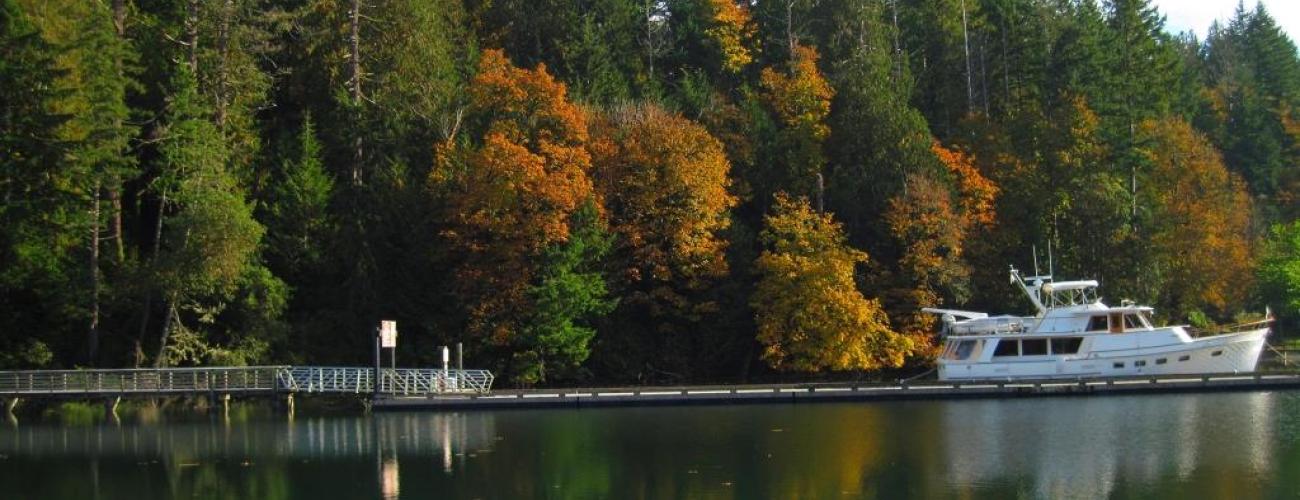Penrose Point State Park History
Penrose Point State Park preserves a landscape that was a beloved summer retreat for a family that played a prominent role in education and public service in Washington State.
The winding saltwater passageways of southern Puget Sound, including Carr Inlet surrounding Penrose Point, were molded and scoured by glacial meltwaters at the close of the Pleistocene ice age.
Indigenous Lands
Penrose Point State Park lies within the traditional territories of Coast Salish Indigenous people whose present-day descendants include members of the Squaxin Island Tribe, Suquamish Tribe, Nisqually Indian Tribe, and Puyallup Tribe. For thousands of years this area has provided habitat for a diverse community of life that forms the basis of their cultures.
Local tribes ceded ownership of the area to the US federal government under duress in the Treaty of Medicine Creek in 1854, keeping rights to harvest natural resources in their usual and accustomed places including the Key Peninsula and surrounding waters.
Land Distribution
Government surveys were completed between 1854 and 1858 and most of the land in today’s Penrose Point State Park was granted to the State of Washington at statehood in 1889 as a part of millions of acres of lands held in trust “for all the people” to provide financial support for public schools and other public institutions.
The land occupied by today’s park campground was acquired by local boatbuilder Carl O. Lorenz as a Cash Entry patent in 1896, a type of cash sale of public domain lands. Lorenz achieved fame as builder of many of the vessels in Puget Sound’s “Mosquito Fleet” ferries that provided the primary means of transportation between Puget Sound communities before automobiles became predominant.
Seven acres at the tip of today’s Penrose Point, along with the southeastern corner of the park, were granted to the Northern Pacific Railway (NP) in 1895, part of nearly 40 million acres of public lands granted to the railroad by the federal government to subsidize the construction of the line. As with most of its granted lands, the NP sold these parcels to other private landowners.
Penrose Family Summer Camp
Stephen B. L. Penrose and his wife Mary Shipman Penrose first visited the area that would eventually bear their name in the 1890s. Stephen was a long-time president and trustee of Whitman College in Walla Walla while Mary was a beloved leader of the YWCA organization. They came with their children as guests of the Delano Hotel, located just south of today’s park. The hotel, run by a couple who had relocated from Maine, was a regular stop on the Mosquito Fleet ferry boats.
Enchanted with the cool seaside retreat and its spectacular views of Case Inlet and Mount Rainier, the Penroses purchased the former NP grant land at the tip of the point (called Prospect Point at the time) in 1901, and later leased the adjoining state trust land to create a summer camp for their family and guests. The Penroses built trails and tent and kitchen platforms in the woods. They named the camp The Madronas, and the peninsula became known as Penrose Point. After Stephen Penrose’s death in 1947, the trust land lease lapsed. The Penrose camp at the tip of the point was sold and eventually subdivided into small lots. After the sale, Mary wrote to her children that “of course it is a grief, but nothing can destroy the memories of the many years we did have there, and I hope it will always bear the name of Penrose Point.”
Creating a State Park
On May 20, 1953, the Washington State Parks and Recreation Commission (WSPRC) requested the withdrawal of the state trust lands on Penrose Point for park purposes, and Commissioner of Public Lands Otto A. Case ordered the withdrawal on August 10, 1953, leasing the land to the WSPRC for an annual rental of $300. A group of adjacent tax delinquent lots on the former NP grant lands were sold to the WSPRC by Pierce County in 1954 and 32 acres of the Lorenz Cash Entry patent were purchased by the WSPRC in 1955.
In 1971, the Washington Legislature decided that continued lease of trust lands for park purposes was not in the best interest of the state and directed the Department of Natural Resources (DNR) and Washington State Parks and Recreation Commission (WSPRC) to negotiate a sale of the leased lands. The two agencies entered into a contract for the purchase of 15,083 acres in 24 parks, including 73 acres in Penrose Point State Park, at a total purchase price of $11.4 million. However, the timber on the lands was excluded from the contracts, as there was no source of funding.
The timber in Penrose Point State Park was appraised to be more than 1.5 million board feet valued at nearly $500,000. In 1980, the legislature authorized the sale of bonds to cover the cost of the timber; on September 28, 1981, the timber in Penrose Point State Park was deeded to the WSPRC, securing its permanent protection.
In 1981-1987, the WSPRC purchased each of the 12 lots of the former Penrose camp to complete the protection of this enchanting corner of Puget Sound.
Sharing the histories of Washington’s state parks is an ongoing project. Learn more here.

